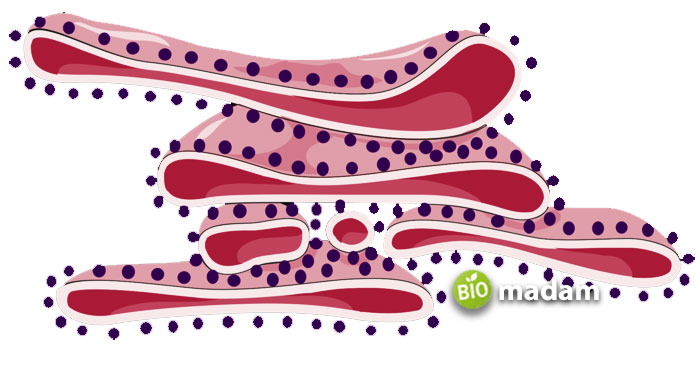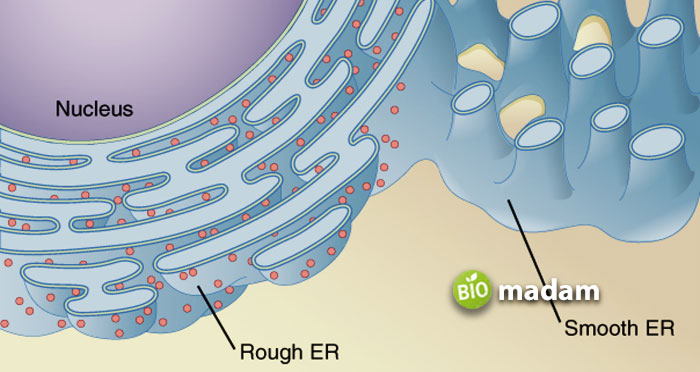The smooth and rough endoplasmic reticulum is present in all types of eukaryotic cells. They perform vital functions in the cell, including protein production, lipid manufacturing, metabolism, storage, and transport. However, these membrane-bound organelles are completely absent in prokaryotes, unlike eukaryotes. The most prominent difference between smooth and rough ER is the presence of ribosomes. The rough endoplasmic reticulum has ribosomes attached to it, whereas the smooth endoplasmic reticulum lacks them. Let’s tell you further differences between the two for a clearer understanding.
Comparison Table
| Characteristics | Smooth ER | Rough ER |
| Definition | Smooth part of ER | Rough part of ER |
| Ribosomes | Absent | Present |
| Appearance | Smooth | Rough |
| Origin | Rough ER | Nuclear membrane |
| Location | Near plasma membrane | Near Golgi apparatus |
| Structure | Tubules and vesicles | Cisternae |
| Connection with Membrane | Plasmalemma | Nuclear membrane |
| Vesicles | Oleosomes | Lysosomes |
| Ribophorins | Absent | Present |
| Function | Lipid synthesis, Ca2+, and glucogenesis | Protein and enzyme synthesis |
What is the Endoplasmic Reticulum?
The endoplasmic reticulum is a sack-like organelle comprising flattened sacs. It is present in the cytoplasm alongside the plasma membrane. It plays a major role in the synthesis, folding, and modification of proteins. It also serves in transportation. Studies show that the ER makes up more than half of the cell’s membranous content. The endoplasmic reticulum is of two types; rough ER and smooth ER.

Smooth Endoplasmic Reticulum
Smooth ER is the tubular part of the endoplasmic reticulum. It is smooth in appearance because of the lack of ribosomes. It is found in the cytosol of cytoplasm. SER is present in all eukaryotic cells and majorly involved in lipid synthesis. Gonadal cells, striated muscle cells, hepatocytes, and sebaceous glands have a high concentration of SER compared to others.
Structure of Smooth Endoplasmic Reticulum
Smooth ER is a membrane-bound tubular network that also contains vesicles. The tubules are the wide, tubular branches present along the cell membrane. Alternatively, the vesicles are rounded and dispersed in the cytoplasm. They provide a higher surface area for storing enzymes. The tubules interconnect and form a three-dimensional reticulum. Their diameter is more variable than RER. You may also find SER in the form of a spiral assembly of cisternae. Cisternae are the folds of the endoplasmic reticulum. A phospholipid membrane resembling the plasma membrane encloses the smooth endoplasmic reticulum.
Function of the Smooth Endoplasmic Reticulum
While the rough ER plays a vital role in protein synthesis, the smooth one produces lipids. It contributes to cellular metabolism, including carbohydrate metabolism and drug detoxification. The presence of the smooth endoplasmic reticulum depends on the function of that organ or tissue. The fundamental functions of the smooth endoplasmic reticulum include:
- The localized enzymes in the smooth endoplasmic reticulum facilitate lipid synthesis and storage.
- It contains the glucose 6-phosphate required for glucogenesis. This enzyme is essential for the regulation of the last step of the process.
- The smooth endoplasmic reticulum is involved in calcium concentration regulation. It also stores calcium used in various processes like the secretion of vesicles.
- The SER adds a hydroxyl group to drugs and enables them to excrete from the body easily.
Rough Endoplasmic Reticulum
The rough endoplasmic reticulum is the other part of the endoplasmic reticulum. It contains ribosomes that act as an essential unit for protein synthesis and secretion. It also synthesizes different types of proteins, digestive enzymes, and hormones. You may not know, but the rough endoplasmic reticulum does not always have ribosomes. They bind to the ER when synthesizing proteins.
Structure of Rough Endoplasmic Reticulum
The rough endoplasmic reticulum is continuous with the nuclear envelope of the nucleus. It occurs as a series of flattened sacs in the cytoplasm. The Rough ER is present near the Golgi apparatus in the cell. It has ribosomes attached to the surface, giving it a grainy appearance. These ribosomes are essential for the production of proteins in the ER.
Function of the Rough Endoplasmic Reticulum
Unlike the smooth endoplasmic reticulum, the rough ER is not involved in multiple functions. The fundamental job of the rough ER is the production of proteins through the translation process. Moreover, it also contributes to manufacturing membranes.

Difference Between Smooth and Rough ER
Definition
Smooth ER
The smooth endoplasmic reticulum is a lipid synthesis site without ribosomes.
Rough ER
The rough endoplasmic contains ribosomes involved in protein synthesis.
Ribosomes
Smooth ER
SER does not have ribosomes attached to it.
Rough ER
However, in all the eukaryotic cells, including animal and plant cells, ribosomes are present on the surface of RER for protein synthesis.
Appearance
Smooth ER
The smooth endoplasmic reticulum has a smooth outer appearance.
Rough ER
At the same time, the outside of the rough endoplasmic reticulum appears grainy due to the presence of ribosomes.
Origin
Smooth ER
Smooth ER may originate from its rough counterpart by shedding ribosomes.
Rough ER
Conversely, rough ER originates from the nuclear membrane.
Location
Smooth ER
It is present near the plasma membrane.
Rough ER
On the other hand, RER is in the cytoplasm near the Golgi apparatus.
Structure
Smooth ER
It contains tubules and vesicles. Tubules are long and wide, while vesicles are round and dispersed.
Rough ER
Whereas, rough ER is composed of cisternae and some tubules.
Function
Smooth ER
SER helps in lipid synthesis, glucogenesis, drug regulation, etc.
Rough ER
Alternatively, RER synthesizes proteins and a few enzymes.
Membrane Connection
Smooth ER
The smooth endoplasmic reticulum connects to the plasmalemma.
Rough ER
However, the rough endoplasmic reticulum connects to the nuclear envelope surrounding the nucleus.
Vesicle Formation
Smooth ER
Smooth ER gives rise to Oleosomes (Spherosomes).
Rough ER
On the contrary, rough endoplasmic reticulum forms lysosomes.
Ribophorins
Smooth ER
Smooth ER does not have Ribophorins.
Rough ER
Unlike SER, Rough ER has ribophorins that help ribosomes attach to the surface.
The Bottom Line
The endoplasmic reticulum is present in almost all eukaryotes and contributes to various functions. The difference between smooth and rough ER is the presence of ribosomes. Ribosomes are present in the rough ER that contribute to protein synthesis. On the other hand, the smooth endoplasmic reticulum does not have ribosomes. It produces lipids and glucose and acts in the regulation of calcium and drugs. They are vital to cellular functions as they play a major role in cellular metabolism.

Anna has completed her degree in Pharmacy from the University of Hawaii. She is serving as a research assistant in a pharmaceutical company. She had a great interest in writing blogs, traveling to different parts of the US, and trying delicious recipes in her spare time.

